Two days prior to the annual conference, the World Future Society offer full-day master classes. These sessions are run by leading global experts in futurism and professional foresight and are designed to provide fundamental, contextual and interactive scenario-based learning. Wendy, Hannah and Sun all attended different classes over the two days. Read below to find out which classes each of us took and the key observations that we made.
On Thursday 23 July Hannah attended the Rigorous Futures: Learning to Harness Logic, Creativity, Systems Thinking and Intuition master class. This class was run by Richard Lum and Wendy Schultz. Richard is the CEO of Vision Foresight Strategy and Wendy is the director of Foresight Research and Training at Infinite Futures. During the session Richard and Wendy introduced eight different methods and tools for conceptualising futures. One of these tools was the three horizons framework, which Hannah found extremely interesting and useful. This foresight tool introduces the idea of three interconnected waves of thinking for the future:
- Horizon one is all about maintaining stability. It looks at what has worked in the past and continues to use these tools. The mindset for horizon one is that of the manager.
- Horizon three is about transformation and disruption. This looks at pockets of the future that have not presented themselves yet and disregards the paradigms of the past. The mindset for this horizon is the visionary.
- Horizon two is about creating and managing change. This horizon looks both ways. It understands the limitations of the past (horizon one) and the opportunities of the future (horizon three). This is the entrepreneur mindset.
Note that this framework jumps from horizon one, to horizon three, back to horizon two. This is because you need to understand the present (horizon one), and all the potential futures (horizon three) in order to influence change productively. Below is a slide from this master class.
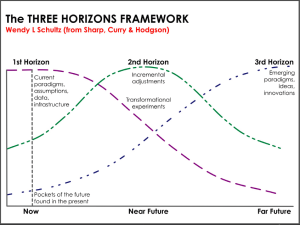
Our designer Sun attended the master class Bringing Future to Life. This was led by Trevor Haldenby, an imaginative futurist who tells new kinds of stories about the implications of emerging technologies. In 2020, Trevor founded The Mission Business Inc., a boutique consultancy that applies methods and tools from participatory design, interactive performance, transmedia storytelling and pervasive gaming that deals with the future.
The Mission Business Inc.’s mind-blowing project ByoLogyc is a fictional human-centred lifestyle biotechnology company that went on a 9-month simulation of the outbreak of a synthetic pandemic in Toronto. This project showcased great ways of using human-scale storytelling as a foresight method along with theatre, game and transmedia, and personalised artifacts that extend the story experience for its audience.
Trevor says that transmedia world building is an essential design skill in the 21st century. Trevor outlined the three design rules of Transmedia Storytelling:
- Build a story world, not a single narrative – by doing this you can create several areas for the audience to connect to.
- Spread the story across media ecologies – there are so many different types of social media that can be used, such as Twitter, Instagram and YouTube. You can maximise the impact of the content by considering the unique strengths of each medium.
- Engage audiences as creators and curators, not just consumers – you need immersive and interactive stories to widen your audience, especially to include the generation that has grown up with modern technology.
This idea was inspired by Henry Jenkins and Nathan Shedroff’s work; see slides below.
On Thursday 23 July I attended the master class Would you like to play a game? A facilitated introduction to using and developing foresight gaming systems. What resonated with me were the terms and processes utilised by the presentation team. I really liked the use of the term ‘hack’, as in to hack a game design. I have always used ‘stress-test’ to challenge the integrity of a framework or system; so it was great to be introduced to a term that was broader, creative, more fun and considerably looser. This will be a very useful concept for the Institute going forward. The exercise we undertook to illustrate this concept was excellent. See the key ways to hack on the slide below.
I also liked how they used action words to enable participants to move quickly into making recommendations. This was an effective tool to speed up engagement. See the slide below.
Lastly, we discussed game design as a research tool. This was something I was a little sceptical about but I now fully understand its purpose and the opportunity it creates. I liked how one of the presenters talked about games being an improvement on a survey tool in that they enable deeper understanding of an issue and development of possible solutions in real time. I also liked how they used the first game to clear away myths and assumptions so that the second game was more effective. They did this by not using a time frame in the first game and then in the second game using a time in the future e.g. 2050. This worked effectively in our exercise.

There is a lot that I will take back to New Zealand as a result of this master class. Thanks to the presenters for their free and frank discussion; it was worthwhile flying to San Fran just to hear this first session.
On Friday 24 July Hannah attended the class Introduction to Foresight. This class was led by Andrew Hines and Lee Shupp. Andrew is currently an assistant professor and program coordinator for the strategic foresight course at the University of Houston. Lee Shupp is the Director of Insights and Strategy at Speck Design. Below is a photo of Andrew Hines during the presentation.
This session began with the Herman Brain Dominance Instrument (HBDI) where Andrew and Lee expressed the importance of having strong teams that utilise diverse thinking perspectives. They then went on to outline theories of change and the three horizons framework (discussed the previous day at the Rigorous Futures master class). Andrew and Lee described the six steps to analysing the future in a corporate setting (which is easily translated into public policy). The six steps are:
- Framing – determining the team you are working with and the subject you are looking at.
- Scanning – finding what you are looking for. This is different from research as it involves looking at the current conditions and the ‘weak signals’ of change. This is where you would find trends that may contribute to your foresight thinking. When scanning it is best to identify 50 to 150 different trends that may relate to the specific topic you are looking at.
- Forecasts – this is where you define your four alternative futures – the 4 P’s (Possible, Plausible, Probable and Preferred). Here, scenarios are used to help determine these alternative futures. It is important to outline assumptions under forecasts because you can’t see the changes if you don’t understand these assumptions.
- Mapping – this is what futurists bring to the table. Mapping allows the futurist to take alternative futures and map out what needs to happen in order for your preferred future to occur, and also what consequences (both positive and negative) will arise from the alternative futures.
- Visioning – this is an important feature of developing alternative futures and bringing them to fruition. You need to have a good strategic vision so that your organisation or employees are motivated by the vision. It is best to co-create your vision.
- Planning – this is about understanding what we need to do in order to reach our preferred future and vision. This is bridging the gap between where an organisation is and where that organisation wants to be.
- Acting – this is putting the strategic plan into practice.
During this session participants were grouped and asked to choose a specific topic to practice the skills learned throughout the master class. Here Andrew and Lee helped participants work through the first four steps of strategic foresight. Hannah’s group focused on the Future of Television. The group framed their foresight work by choosing a stakeholder – a major cable network (which they called AMN). Through quick scanning and forecasting the group decided that the probable future for AMN was a decrease in cable TV demand due to increased demand for online streaming sites such as Netflix. Future mapping techniques, including a future wheel, were used to uncover what unintended consequences would arise from such a change in demand. The group also identified a micro-trend of holographic projection TVs that AMN should keep an eye on. This could be a market for AMN to move into as cable TV memberships decreased. See some of the worksheets from the day below.

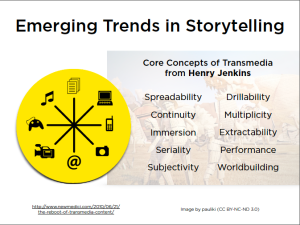
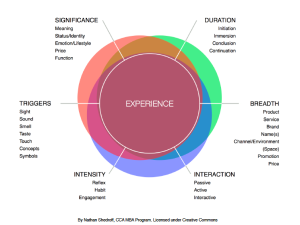
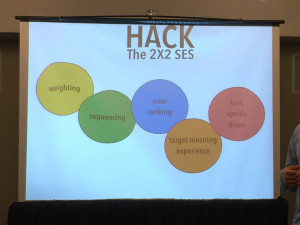
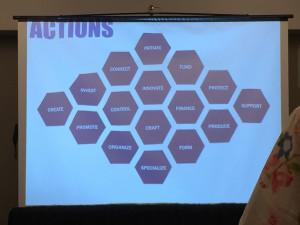
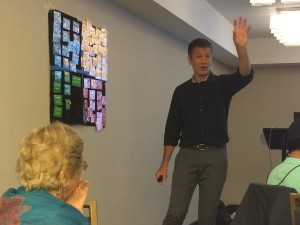

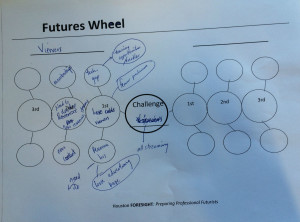
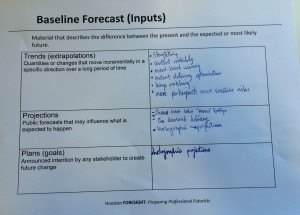




















![20160906 McGuinness Institute - TacklingPovertyNZ Workshop – Far North Flyer [FINAL]](/wp-content/uploads/20160906-McGuinness-Institute-TacklingPovertyNZ-Workshop-%E2%80%93-Far-North-Flyer-FINAL-1-50x50.png)